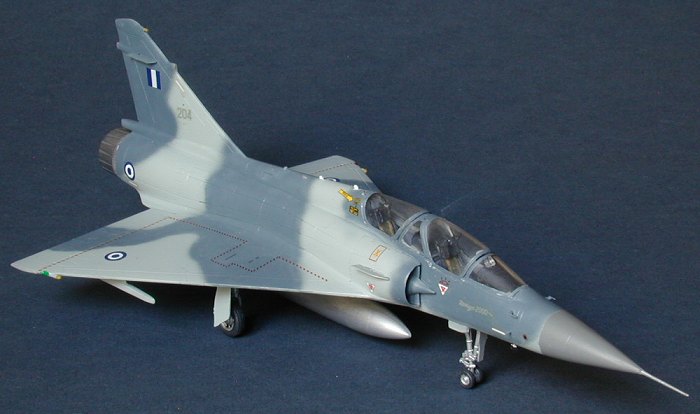
Italeri 1/72 Mirage 2000D
|
KIT # |
023 |
|
PRICE: |
€ 6.65 (on sale |
|
DECALS: |
Four options: 2 France, 1 Greece, 1 Taiwan |
|
REVIEWER: |
Lars Jørgensen |
|
NOTES: |

|
HISTORY |
The Mirage 2000 was Dassault's follow-on development after the Mirage F1. The wing planform was again a delta as for the Mirage III. The wings gained leading edge slats, some small foreplanes where fitted and a fly-by-wire flight control system was used. Of course, a more powerful engine was fitted, the SNECMA M53.
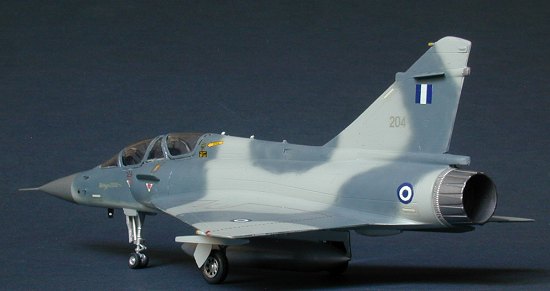 The Mirage 2000 went through a number of variants,
adapting the airframe for different roles. The Mirage 2000A's main task
is air defence, as well as the 2000C. The 2000B and 2000D are double
seaters, employed as a trainer. The 2000D is also used as a dedicated
strike aircraft. The 2000N is a double-seat aircraft used for the nuclear
strike mission and has a strengthened airframe.
The Mirage 2000 went through a number of variants,
adapting the airframe for different roles. The Mirage 2000A's main task
is air defence, as well as the 2000C. The 2000B and 2000D are double
seaters, employed as a trainer. The 2000D is also used as a dedicated
strike aircraft. The 2000N is a double-seat aircraft used for the nuclear
strike mission and has a strengthened airframe.
With later versions the naming became more confusing. Mirage 2000-5/2000-5 Mk 2/2000-9 are different upgrades and both single and double seaters. These are mainly avionics upgrades, in part new electronics developed for the Rafale have been integrated in the Mirage. This looks to be a bit of a problem for Dassault, as the 'deux-mille' is competing for the same contracts as their new Rafale. The Rafalé with two engines must certainly represent a higher investment and has not secured any export orders so far.
|
THE KIT |
What is the kit situation for the Mirage 2000 in 1/72 scale? Let me give a short rundown:
§ Heller 2000 C, raised panel lines, a bit soft on details, French decals
§ Heller 2000 N, modification of the C, new fuselage with engraved panel lines, includes the prominent drop tanks and an ASMP, French decals
§ Airfix 2000 C, this is a reboxed Heller kit
§ Italeri 2000 C, engraved panel lines, decals for French and Greek aircraft
§ Italeri 2000 D, as described here
§ Lee 2000D, a copy or rebox of the Italeri 2000D
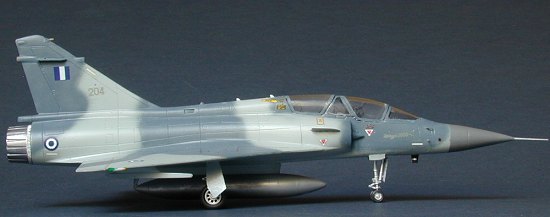 OK, the kit for this review is the Italeri offering
for the 2000D, which comes in an end-opening box. The plastic parts are
included on two sprues of gray plastic. The engraving is mixed, mainly
engraved, with raised lines on the pylons. Also the depth of the
engraving varies, with stronger lines on the fuselage, but looks quite
usable. The cockpit is fitted out the usual way for this scale, the
instrument panels have raised detail and the multi-part ejection seats
look not bad. As stores we get the a big under-fuselage drop tank, two
air-to-surface missiles (AS.30) and two laughable 'Magic' AAM. Also, a
targeting pod is supplied.
OK, the kit for this review is the Italeri offering
for the 2000D, which comes in an end-opening box. The plastic parts are
included on two sprues of gray plastic. The engraving is mixed, mainly
engraved, with raised lines on the pylons. Also the depth of the
engraving varies, with stronger lines on the fuselage, but looks quite
usable. The cockpit is fitted out the usual way for this scale, the
instrument panels have raised detail and the multi-part ejection seats
look not bad. As stores we get the a big under-fuselage drop tank, two
air-to-surface missiles (AS.30) and two laughable 'Magic' AAM. Also, a
targeting pod is supplied.
Decals are supplied for four aircraft: a gray-green French aircraft, another French in desert camouflage as used for 'Red Flag' and blue-gray Mirages from Greece and Taiwan. Decals look nice on a first look, but have some problems, this will be dealt with later.
|
CONSTRUCTION |
Construction began by assembling the large drop-tank. As the mid-wing stations where not to be used, their slots in the lower wing where closed with some plastic sheet and filler. Then some smaller parts and the interior were sprayed while still on the sprue. The cockpit parts were assembled, the result looked quite nice. The ejection seat with the long canopy breaker goes in up front.
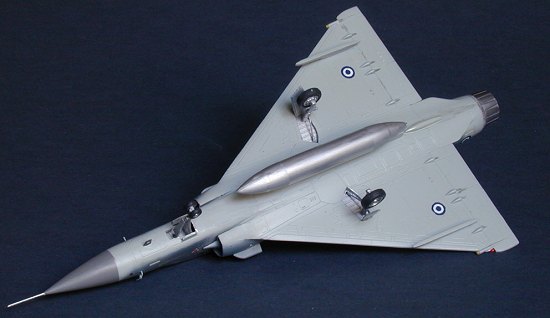 Then, with some nose ballast added, the fuselage
was joined. With the fuselage dry the intake and wing parts where added
in a single session to get the best fit. The wing's fit to the fuselage
was quite good, as well as for the intakes to the fuselage. Only at the
lower part of the intakes meeting the wings there was a step which had to
be dealt with some filler. Well, due to the simple configuration of the
Mirage, after no time, the main assembly was done.
Then, with some nose ballast added, the fuselage
was joined. With the fuselage dry the intake and wing parts where added
in a single session to get the best fit. The wing's fit to the fuselage
was quite good, as well as for the intakes to the fuselage. Only at the
lower part of the intakes meeting the wings there was a step which had to
be dealt with some filler. Well, due to the simple configuration of the
Mirage, after no time, the main assembly was done.
Only the big drop tank was used as well as the outer, empty missile rails. As a hint, the very prominent under wing tanks and Mica missiles used on Mirage 2000s are found in Italeri's Rafalé kit.
Continuing with the the assembly, now came two small modification for the Greece aircraft: a small sensor was added to the fin and a blade aerial was added to the nose. I think there should also be a small hump on the spine, which I missed. AoA and pitot pressure sensors where added to the fuselage sides. The canopies were added, here fit was not good, it might be simpler to pose them open. The clear parts were masked carefully with Parafilm M and the kit kit was ready for painting.
|
COLORS & MARKINGS |
As I had chosen the Greek option, my 'Deux-Mille' was to have that attractive gray-blue camouflage. Painting instructions where confusing and the shades looked different on every photograph. Fellow modeler Burkhard convinced me that the Mirage is found in a blue-gray as well as in two-tone gray camouflage. In the end I settled for FS 36375 ‘Light compass Gray’ and FS 35164 (Humbrol 144 'Intermediate Blue'). There are also two 'Mirage2000 Grays' on offer from Xtracolor for the more accurate modeler.
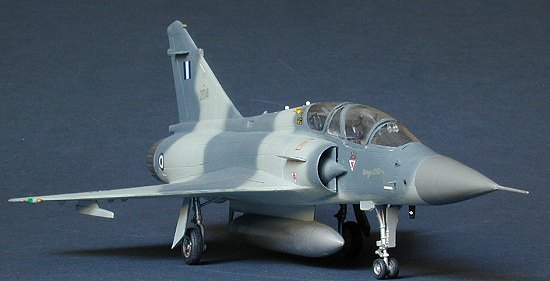 Painting began by spraying the wheel wells silver,
the external fuel tank got a coat of MM Metalizer. The radome was shot
with Hu 140 (Gull Grey, FS 36231). Strangely, there is no panel line
engraved for the radome, so the border had to be set freehand. These
parts where masked and the model was given a coat of Light Compass Gray.
After this had dried overnight, the blue came next. Being a lazy guy,
this was applied freehand with the airbrush. It came out quite nice, but
was a not a simple job. The more serious modeler would invest some time
and use some card masks.
Painting began by spraying the wheel wells silver,
the external fuel tank got a coat of MM Metalizer. The radome was shot
with Hu 140 (Gull Grey, FS 36231). Strangely, there is no panel line
engraved for the radome, so the border had to be set freehand. These
parts where masked and the model was given a coat of Light Compass Gray.
After this had dried overnight, the blue came next. Being a lazy guy,
this was applied freehand with the airbrush. It came out quite nice, but
was a not a simple job. The more serious modeler would invest some time
and use some card masks.
After a gloss coat it was time for the decals, the kit supplied decals are not very accurate. The walkway lines are too wide, these have to be cut in half, not an easy job. The formation keeping lights are a bright yellow when they have to be a yellowish white. The markings for the Greek aircraft are the wrong color and the roundels diameters are not correct. I made these from circles punched form solid color decal sheet. These are not exact either, but look a lot better. Here again, should you be more serious than I am, a selection of aftermarket decals are available, I think Decals Carpena make some nice sets for the Mirage 2000.
While happily going along applying the decals I suddenly noticed that the cockpit is set to far back by 5mm!
Also, the seats sat to low for my opinion. Here I went, carefully removing the canopies, then the seats came off after a short fight. Some card stock was placed under the seats. Test-fitting the canopies, these would not fit, as the seat tops are to wide. The seat sides came off, the headrests where filed smaller and the side parts modified. At last everything looked OK.
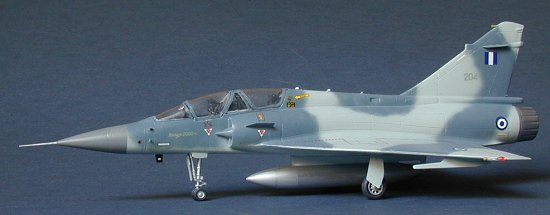 Well, finishing progressed with some detail
painting. The gear came on, here too there where some fit problems.
Please notice, that the main gear struts have a marked toe-in. I had to
cut the front strut of the nose gear, I don't know if that is a kit
problem or did I misfit the nose gear bay. I had some trouble fitting the
cannon barrels under the belly. When I finally had fixed them with super
glue, I read in a reference that the cannons where omitted from the
2000D. This is also true for the Greek aircraft, so off came the cannons.
Filling the recesses was not easy with the aircraft so for assembled.
Also note that there are some humps and lumps on the airframe for the
Greece aircraft that I did not add.
Well, finishing progressed with some detail
painting. The gear came on, here too there where some fit problems.
Please notice, that the main gear struts have a marked toe-in. I had to
cut the front strut of the nose gear, I don't know if that is a kit
problem or did I misfit the nose gear bay. I had some trouble fitting the
cannon barrels under the belly. When I finally had fixed them with super
glue, I read in a reference that the cannons where omitted from the
2000D. This is also true for the Greek aircraft, so off came the cannons.
Filling the recesses was not easy with the aircraft so for assembled.
Also note that there are some humps and lumps on the airframe for the
Greece aircraft that I did not add.
|
CONCLUSIONS |
Well, the finished 'Deux-Mille' looks very nice in its blue-gray finish, I also like the look of the Greek markings.
I enjoyed very much the assembly of the kit and would have loved to give it the highest ratings. Engravings are the best I have seen with an Italeri kit and of Tamigawa quality, also the fit was not bad.
But, sorry, the cockpit is to far offset to call it a perfect kit, also calling for some improvement is the decal sheet. Adding to this are some smaller, annoying mistakes. Well, on the other side you have also to pay less for the kit, at least here in Germany, compared to Tamigawa offerings. Anyway, if they could follow this kit and avoid their glitches, the folks at Italeri are on the right way.
July 2004 If you would like your product reviewed fairly and quickly, please contact
me or see other details in the Note to
Contributors.